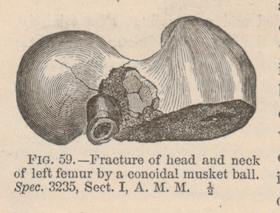Title: Phillips, Henry
Source text: The Medical and Surgical History of the War of the Rebellion. (1861-65.), Part 3, Volume 2 (Washington, DC: Government Printing Office, 1883), 106-107.
Civil War Washington ID: med.d2e5364
TEI/XML: med.d2e5364.xml
CASE 249.—Private Henry Phillips, Co. I, 146th New York, a robust man, aged 34 years, was wounded at the South Side Railroad, near Petersburg, on April 1, 1865, by a conoidal musket ball, which entered the left thigh and lodged against the anterior surface of the neck of the femur. The patient was conveyed to the field hospital of the 2d division of the Fifth Corps, and thence by ambulance and rail to City Point, where he arrived on April 4th, and was transferred by steamer to Washington, and, on April 6th, was admitted into Douglas Hospital. He was much exhausted and had considerable fever, though in frequency the pulse and respiration were nearly normal. The wound was painful, and the beginning of its grave constitutional aspect was becoming manifest. There was no shortening or deformity of the limb. At a preliminary exploration the ball was found impacted near the anatomical neck, and was extracted. The limited nature of the fracture was also ascertained, and excision was decided on. On April 8th the patient was placed under the influence of ether, and Assistant Surgeon William F. Norris, U. S. A., excised the head, neck, and trochanter major through a curved incision six or seven inches in length with its convexity forward. About twelve or sixteen ounces of blood were lost during the operation. One small artery required a ligature. The ball had crushed in the laminated structure of the anterior face of the neck, and from this cup-shaped cavity a small fissure ran up the articular surface and a deep fissure nearly around the neck; but the separation between the head and neck was incomplete. During the operation this fracture was converted into a complete one in rotating the bone to facilitate the exarticulation. The operation concluded, the limb was supported by pillows, and the patient was ordered beef tea and milk punch every three hours, and a full dose of opium at midnight. He had another dose of laudanum at four o'clock the next morning. On the 9th, 10th, and 11th, there was little pain, and anodynes were not required, but concentrated nourishment and stimulants were assiduously administered. It was thought the nurse exceeded his instructions in the amount of whiskey given, for on April 12th, the patient had hiccough and nausea, and his breath was redolent of alcoholic fumes. He was now transferred to the immediate charge of Acting Assistant Surgeon C. Carvallo. A laxative enema was administered, and, when the bowels were unloaded, a sinapism at the epigastrium, and small doses of creasote allayed the irritability of stomach. On April 13th the stomach was quiet, pulse 120, rather weak, and there was profuse perspiration. The patient was ordered a cupful of beef tea every two hours, one of milk punch every four hours, milk toast and soft boiled eggs at breakfast and dinner. No change the next day. On the 14th the wound looked well. Some shreds of disorganized connective tissue were removed by the dressing forceps. There was some pain and difficulty in micturition. Small doses of tincture of the sesquichloride of iron were directed thrice daily, and chicken broth was added to his dietary. No entry of importance appears on the 16th. On the 17th the pulse was 120, respiration 32. Slight pain on right side, and signs of pleurisy on auscultation. There was an erythematous blush about the wound, and, in the evening, there was diarrhœa, which was cheated by pills of opium and nitrate of silver. On the 18th the pleurisy was worse, the breathing more rapid, and there was retention of urine, so that it was necessary after this to use a catheter. April 19th the countenance was sunken, and the wound was flabby. There was a sore on the sacrum. The patient was moved to a Crosby Invalid Bed. He had a draught containing ammonia and sugar, and a blister on his side. April 20th the nurse reported a chill during the night. The breathing was labored. There were sordes on the teeth. At the next morning visit the patient was very low. He died before noon, April 21, 1865, eleven days after the operation. The autopsy revealed dry pleurisy on either side; lungs healthy, somewhat congested posteriorly; heart and liver not abnormal. A large sub-peritoneal abscess in the course of psoas and internal iliac muscles, which appeared to originate in the obturator foreamen and ascend along the left iliac fossa, denuding the bone of its periosteum. No evidences of pyæmia were found, though it was strongly suspected after the occurrence of the chill on April 20th. The pathological specimen, contributed by the operator to the Army Medical Museum, is represented at page 246 of the Catalogue of the Surgical Section of 1866, and by the wood-cut (FIG. 59).


